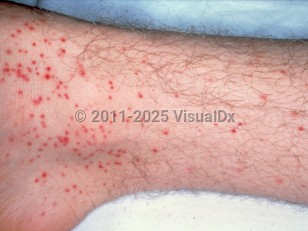Emergency: requires immediate attention
Atypical measles syndrome
Alerts and Notices
Important News & Links
Synopsis

Atypical measles syndrome arises when an individual previously vaccinated with the now long-discontinued killed measles vaccine is exposed to the wild type of measles virus during a community outbreak and subsequently develops disease. This inactivated vaccine, produced in the 1960s, was ineffective in that it failed to produce long-term protective antibody formation, with antibody levels decreasing within months to a couple of years following vaccination. This particular measles vaccine's use spanned from 1963 to 1967. Atypical measles has also been described in patients who have had live measles vaccine.
Patients with atypical measles syndrome typically develop a prodrome characterized by high spiking fever (up to 40°C [104°F]). This is accompanied by myalgia, cough, and headache. The polymorphous rash that develops is erythematous, macular or papular, and begins on the extremities and spreads to involve the trunk. The lesions then become vesicular, petechial, or purpuric. The exanthema generally occurs on the third to fourth day of the illness. Prostration, headache (which may be occipital), nausea, and vomiting may be followed by a sore throat, conjunctivitis, and photophobia. Cough, occasionally with pleuritic pain, is almost universal. A severe pneumonitis occurs in most patients and may be life-threatening. The illness appears to be self-limiting, lasting from 3 to 10 days. Additional clinical features may include abdominal pain and hepatic dysfunction.
Hospitalization should be considered. Other complicating features of the disease can range from mild to severe and include otitis media, pneumonia, acute thrombocytopenic purpura, and encephalitis (2-7 days after the start of the rash). A late and rare complication is subacute sclerosing panencephalitis, which presents with mental deterioration, behavioral changes, and myoclonic jerks.
Related topic: measles
Patients with atypical measles syndrome typically develop a prodrome characterized by high spiking fever (up to 40°C [104°F]). This is accompanied by myalgia, cough, and headache. The polymorphous rash that develops is erythematous, macular or papular, and begins on the extremities and spreads to involve the trunk. The lesions then become vesicular, petechial, or purpuric. The exanthema generally occurs on the third to fourth day of the illness. Prostration, headache (which may be occipital), nausea, and vomiting may be followed by a sore throat, conjunctivitis, and photophobia. Cough, occasionally with pleuritic pain, is almost universal. A severe pneumonitis occurs in most patients and may be life-threatening. The illness appears to be self-limiting, lasting from 3 to 10 days. Additional clinical features may include abdominal pain and hepatic dysfunction.
Hospitalization should be considered. Other complicating features of the disease can range from mild to severe and include otitis media, pneumonia, acute thrombocytopenic purpura, and encephalitis (2-7 days after the start of the rash). A late and rare complication is subacute sclerosing panencephalitis, which presents with mental deterioration, behavioral changes, and myoclonic jerks.
Related topic: measles
Codes
ICD10CM:
B05.89 – Other measles complications
SNOMEDCT:
240483006 – Atypical measles
B05.89 – Other measles complications
SNOMEDCT:
240483006 – Atypical measles
Look For
Subscription Required
Diagnostic Pearls
Subscription Required
Differential Diagnosis & Pitfalls

To perform a comparison, select diagnoses from the classic differential
Subscription Required
Best Tests
Subscription Required
Management Pearls
Subscription Required
Therapy
Subscription Required
References
Subscription Required
Last Reviewed:03/25/2025
Last Updated:03/27/2025
Last Updated:03/27/2025
Emergency: requires immediate attention
Atypical measles syndrome

